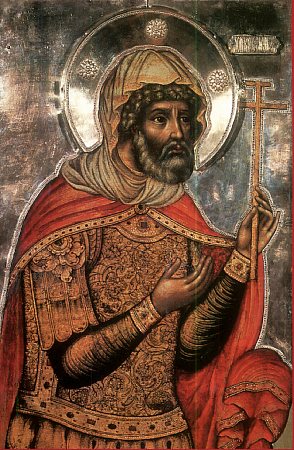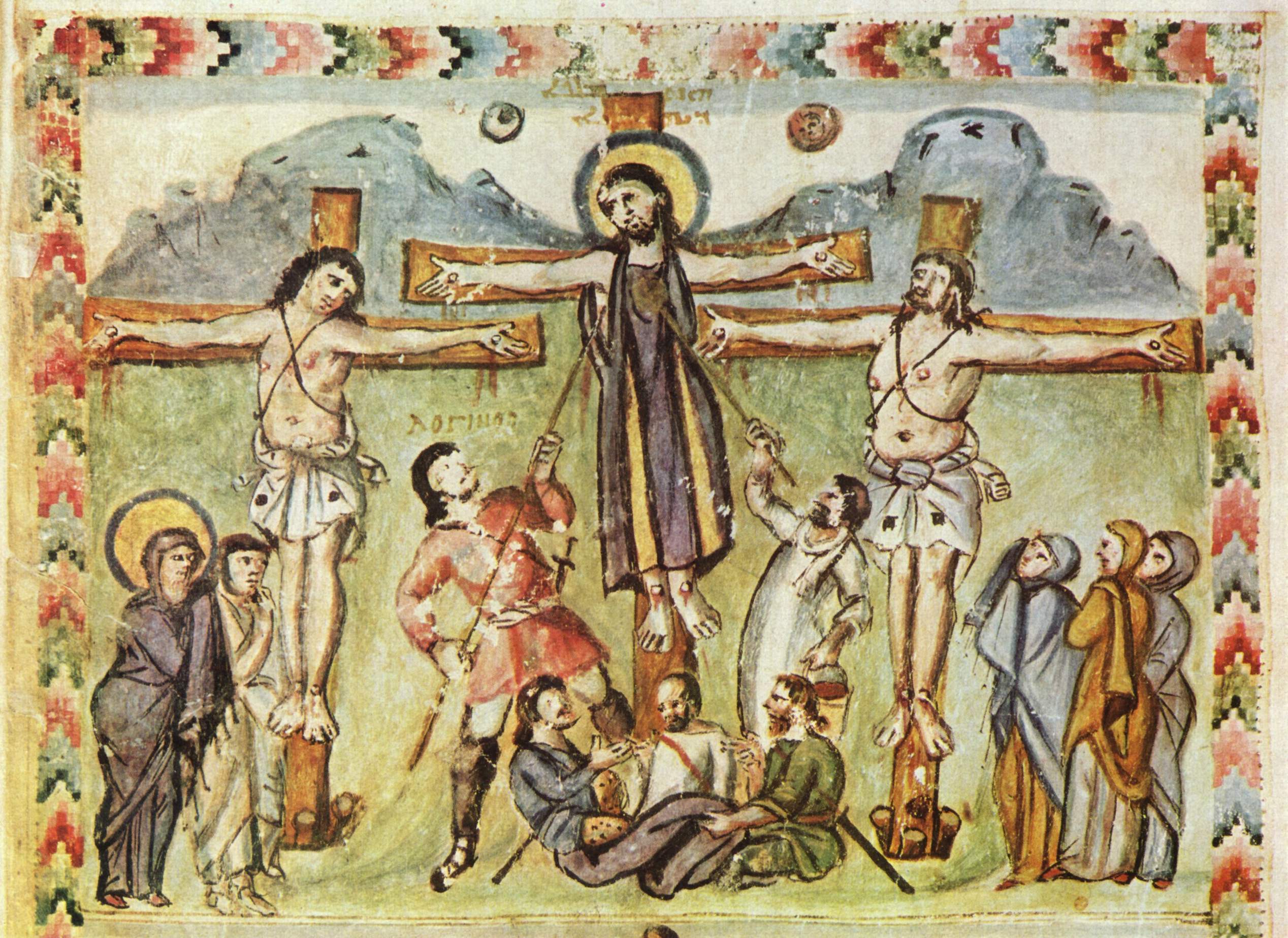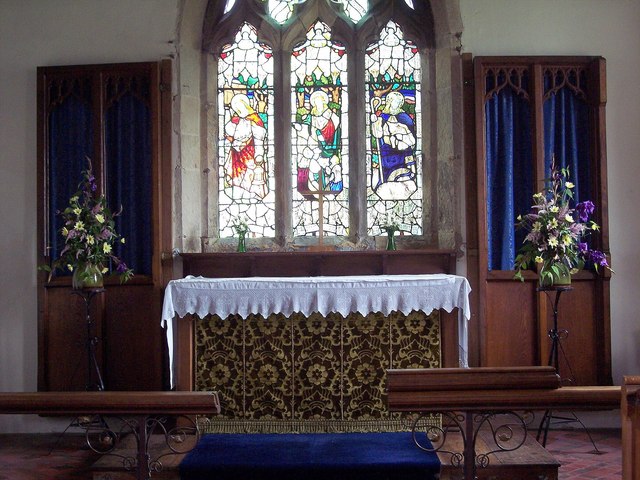|
Església De Sant Joan De Caselles
Església de Sant Joan de Caselles is a church located in Canillo, Andorra. It is a heritage property registered in the Cultural Heritage of Andorra. It was built in the 11–12th century. Art Inside the building different artistic pieces are preserved, the main one being a large stucco image of Christ in Majesty, as well as a mural with Fresco, frescoes depicting scenes from Calvary with Longinus, Saint Longinus and Stephaton, accompanied by the half-hidden Sun and Moon, works from the 12th century. There is also a retable dating from the 16th century of exceptional quality. Influenced by the Italian and Germanic Renaissance style, it depicts scenes from the life and martyrdom of John the Apostle, Saint John the apostle, author of the Book of Revelation, book of revelation and patron saint of the church, in particular his visions in Patmos. References Canillo Roman Catholic churches in Andorra Cultural Heritage of Andorra {{Andorra-church-stub ... [...More Info...] [...Related Items...] OR: [Wikipedia] [Google] [Baidu] |
Canillo
Canillo () is one of the parishes of Andorra. Canillo is also the name of the main town of the parish. The parish is considered the religious center of Andorra with the Sanctuary and Chapel of Our Lady of Meritxell, patron saint of Andorra, and contains one of the best-preserved romanesque churches in the Pyrenees, Sant Joan de Caselles. It has a population of 4,826, as of 2011. Despite having a tourist vocation, the parish of Canillo still retains many livestock and agricultural traits. Geography The localities of Canillo parish include Soldeu, Bordes d'Envalira, El Tarter, Sant Pere, Ransol, Els Plans, El Vilar, l'Armiana, l'Aldosa, El Forn, Incles, Prats, Meritxell and Molleres. Unlike the rest of Andorra, Canillo is divided by ''veïnats'' (neighborhoods). Canillo Parish is Andorra's largest parish, at 121 square kilometers (47 sq mi). Large natural places and areas in the parish include the Incles Valley, the Ransol Valley and the Montaup Valley. On the hiki ... [...More Info...] [...Related Items...] OR: [Wikipedia] [Google] [Baidu] |
Andorra
, image_flag = Flag of Andorra.svg , image_coat = Coat of arms of Andorra.svg , symbol_type = Coat of arms , national_motto = la, Virtus Unita Fortior, label=none (Latin)"United virtue is stronger" , national_anthem = "The Great Charlemagne" , image_map = Location Andorra Europe.png , map_caption = , image_map2 = , capital = Andorra la Vella , coordinates = , largest_city = capital , official_languages = Catalan , ethnic_groups = , ethnic_groups_year = 2017 , religion = Christianity (Catholicism) , religion_ref = , demonym = Andorran , government_type = constitutional elective diarchy , leader_title1 = Co-Princes , leader_name1 = , leader_title2 = Representatives , leader_name2 = , leader_title3 = Prime Minister ... [...More Info...] [...Related Items...] OR: [Wikipedia] [Google] [Baidu] |
Cultural Heritage Of Andorra
The Cultural Heritage of Andorra is an organization in Andorra which protects national buildings and monuments considered of cultural and historical value. Selected buildings listed * Antiga fàbrica de pells * Antiga Vegueria Francesa * Cal Batlle * Cal Pal * Cal Ribot * Casa Balletbó * Casa Blanca, Ordino * Casa Bonet * Casa Cristo * Casa d'Areny-Plandolit *Casa de la Vall * Casa del Quart d'Anyós * Casa dels Russos * Casa Duró * Casa Felipó * Casa Lacruz * Casa Massip-Dolsa * Casa Palmitjavila *Casa Rossell * Casa Vidal * Casa Xurrina * Castell de les Bons * Central hidroelèctrica de FHASA a Encamp * Colomer de Cotxa * Col·legi Sagrada Família, Escaldes-Engordany * Església de Sant Andreu d'Arinsal * Església de Sant Bartomeu de Soldeu * Església de Sant Climent de Pal *Església de Sant Corneli i Sant Cebrià d'Ordino *Església de Sant Cristòfol d'Anyós * Església de Sant Esteve de Bixessarri * Església de Sant Esteve * Església de Sant Iscle i Santa Victòria ( ... [...More Info...] [...Related Items...] OR: [Wikipedia] [Google] [Baidu] |
Stucco
Stucco or render is a construction material made of aggregates, a binder, and water. Stucco is applied wet and hardens to a very dense solid. It is used as a decorative coating for walls and ceilings, exterior walls, and as a sculptural and artistic material in architecture. Stucco can be applied on construction materials such as metal, expanded metal lath, concrete, cinder block, or clay brick and adobe for decorative and structural purposes. In English, "stucco" sometimes refers to a coating for the outside of a building and "plaster" to a coating for interiors; as described below, however, the materials themselves often have little to no differences. Other European languages, notably Italian, do not have the same distinction; ''stucco'' means ''plaster'' in Italian and serves for both. Composition The basic composition of stucco is cement, water, and sand. The difference in nomenclature between stucco, plaster, and mortar is based more on use than composition. Until ... [...More Info...] [...Related Items...] OR: [Wikipedia] [Google] [Baidu] |
Christ In Majesty
Christ in Majesty or Christ in Glory ( la, Maiestas Domini) is the Western Christian image of Christ seated on a throne as ruler of the world, always seen frontally in the centre of the composition, and often flanked by other sacred figures, whose membership changes over time and according to the context. The image develops from Early Christian art, as a depiction of the Heavenly throne as described in 1 Enoch, Daniel 7, and The Apocalypse of John. In the Byzantine world, the image developed slightly differently into the half-length Christ Pantocrator, "Christ, Ruler of All", a usually unaccompanied figure, and the Deesis, where a full-length enthroned Christ is entreated by Mary and St. John the Baptist, and often other figures. In the West, the evolving composition remains very consistent within each period until the Renaissance, and then remains important until the end of the Baroque, in which the image is ordinarily transported to the sky. Development From the latter part ... [...More Info...] [...Related Items...] OR: [Wikipedia] [Google] [Baidu] |
Fresco
Fresco (plural ''frescos'' or ''frescoes'') is a technique of mural painting executed upon freshly laid ("wet") lime plaster. Water is used as the vehicle for the dry-powder pigment to merge with the plaster, and with the setting of the plaster, the painting becomes an integral part of the wall. The word ''fresco'' ( it, affresco) is derived from the Italian adjective ''fresco'' meaning "fresh", and may thus be contrasted with fresco-secco or secco mural painting techniques, which are applied to dried plaster, to supplement painting in fresco. The fresco technique has been employed since antiquity and is closely associated with Italian Renaissance painting. The word ''fresco'' is commonly and inaccurately used in English to refer to any wall painting regardless of the plaster technology or binding medium. This, in part, contributes to a misconception that the most geographically and temporally common wall painting technology was the painting into wet lime plaster. Even in appar ... [...More Info...] [...Related Items...] OR: [Wikipedia] [Google] [Baidu] |
Calvary
Calvary ( la, Calvariae or ) or Golgotha ( grc-gre, Γολγοθᾶ, ''Golgothâ'') was a site immediately outside Jerusalem's walls where Jesus was said to have been crucified according to the canonical Gospels. Since at least the early medieval period, it has been a destination for pilgrimage. The exact location of Calvary has been traditionally associated with a place now enclosed within one of the southern chapels of the multidenominational Church of the Holy Sepulchre, a site said to have been recognized by the Roman empress Helena, mother of Constantine the Great, during her visit to the Holy Land in 325. Other locations have been suggested: in the 19th century, Protestant scholars proposed a different location near the Garden Tomb on Green Hill (now "Skull Hill") about north of the traditional site and historian Joan Taylor has more recently proposed a location about to its south-southeast. Biblical references and names The English names Calvary and Golgotha ... [...More Info...] [...Related Items...] OR: [Wikipedia] [Google] [Baidu] |
Longinus
Longinus () is the name given to the unnamed Roman soldier who pierced the side of Jesus with a lance and who in medieval and some modern Christian traditions is described as a convert to Christianity. His name first appeared in the apocryphal Gospel of Nicodemus. The lance is called in Christianity the "Holy Lance" ('' lancea'') and the story is related in the Gospel of John during the Crucifixion. This act is said to have created the last of the Five Holy Wounds of Christ. This person, unnamed in the Gospels, is further identified in some versions of the legend as the centurion present at the Crucifixion, who said that Jesus was the son of God, so he is considered as one of the first Christians and Roman converts. Longinus' legend grew over the years to the point that he was said to have converted to Christianity after the Crucifixion, and he is traditionally venerated as a saint in the Roman Catholic Church, Eastern Orthodox Church, and several other Christian communions. Or ... [...More Info...] [...Related Items...] OR: [Wikipedia] [Google] [Baidu] |
Stephaton
Stephaton, or Steven, is the name given in medieval Christian traditions to the Roman soldier or bystander, unnamed in the Bible, who offered Jesus a sponge soaked in vinegar wine at the Crucifixion. In later depictions of the Crucifixion, Stephaton is frequently portrayed with Longinus, the soldier who pierced Jesus' side with a spear. Gospel accounts The account of Jesus receiving a sponge soaked in vinegar while on the cross appears in all four of the canonical gospels, with some variation. In both and , just after Jesus says "My God, my God, why have you forsaken me", a bystander soaks a sponge in vinegar and raises it on a reed for Jesus to drink. mentions that the attendant soldiers offer Jesus vinegar while mocking him – moving the mocking motif that occurs earlier in Mark and Matthew to the Crucifixion.Johnson, Luke Timothy, and Daniel J. Harrington (1991''The Gospel of Luke'' p. 375 and note. Liturgical Press. In , Jesus declares "I thirst" (one of his last words) and ... [...More Info...] [...Related Items...] OR: [Wikipedia] [Google] [Baidu] |
Retable
A retable is a structure or element placed either on or immediately behind and above the altar or communion table of a church. At the minimum it may be a simple shelf for candles behind an altar, but it can also be a large and elaborate structure. A retable which incorporates sculptures or painting is often referred to as an altarpiece. According to the Getty ''Art & Architecture Thesaurus Online'', "A 'retable' is distinct from a ' reredos'; while the reredos typically rises from ground level behind the altar, the retable is smaller, standing either on the back of the altar itself or on a pedestal behind it. Many altars have both a reredos and a retable." 'Retable' This distinction is not always upheld in common use, an ... [...More Info...] [...Related Items...] OR: [Wikipedia] [Google] [Baidu] |
John The Apostle
John the Apostle ( grc, Ἰωάννης; la, Ioannes ; Ge'ez: ዮሐንስ;) or Saint John the Beloved was one of the Twelve Apostles of Jesus according to the New Testament. Generally listed as the youngest apostle, he was the son of Zebedee and Salome. His brother James was another of the Twelve Apostles. The Church Fathers identify him as John the Evangelist, John of Patmos, John the Elder, and the Beloved Disciple, and testify that he outlived the remaining apostles and was the only one to die of natural causes, although modern scholars are divided on the veracity of these claims. John the Apostle is traditionally held to be the author of the Gospel of John, and many Christian denominations believe that he authored several other books of the New Testament (the three Johannine epistles and the Book of Revelation, together with the Gospel of John, are called the Johannine works), depending on whether he is distinguished from, or identified with, John the Evangelist, John t ... [...More Info...] [...Related Items...] OR: [Wikipedia] [Google] [Baidu] |




.jpg)
.jpg)



